国际贸易实务(英文版)专门讲 International trade Terms
- 格式:ppt
- 大小:730.50 KB
- 文档页数:57
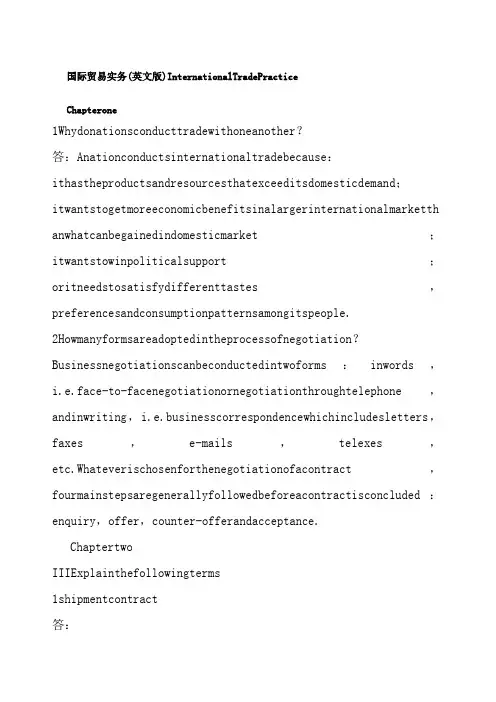
国际贸易实务(英文版)InternationalTradePracticeChapterone1Whydonationsconducttradewithoneanother?答:Anationconductsinternationaltradebecause:ithastheproductsandresourcesthatexceeditsdomesticdemand;itwantstogetmoreeconomicbenefitsinalargerinternationalmarketth anwhatcanbegainedindomesticmarket;itwantstowinpoliticalsupport;oritneedstosatisfydifferenttastes,preferencesandconsumptionpatternsamongitspeople.2Howmanyformsareadoptedintheprocessofnegotiation?Businessnegotiationscanbeconductedintwoforms:inwords,i.e.face-to-facenegotiationornegotiationthroughtelephone,andinwriting,i.e.businesscorrespondencewhichincludesletters,faxes,e-mails,telexes,etc.Whateverischosenforthenegotiationofacontract,fourmainstepsaregenerallyfollowedbeforeacontractisconcluded:enquiry,offer,counter-offerandacceptance.ChaptertwoIIIExplainthefollowingterms1shipmentcontract答:ShipmentcontractisacontractusinganIncotermwhichindicatesthatth edeliveryhappensatthetimeorbeforethetimeofshipment.2symbolicdelivery Symbolicdeliveryisadeliverysituationinwhichwhenthesellerdelive rsthebuyerdoesnotphysicallyreceivethegoods.Thiskindofdeliveryi sprovedbythesubmissionoftransportdocumentbythesellertothebuyer .3arrivalcontract ArrivalcontractmeansacontractusinganIncotermwhichindicatesthat thedeliveryhappenswhenthegoodsarriveatthedestination.4actualdelivery Actualdeliveryreferstoadeliverysituationinwhichwhenthesellerde liversthebuyerdoesphysicallyreceivethegoods.IV.Shortquestions1Whatarethetwotypesoftradetermsconcerningthetransferofrisks 答:Shipmentcontracttermsvs.arrivalcontractterms.Undershipmentcont racttermsseller’sriskwillbetransferredtothebuyerbeforethegood sdepartfromtheplace/portofshipment.Underarrivalcontracttermsse llerwillbeartheriskofthegoodsuntilthegoodsarrivethedestination .2WhatarethedifferencesandsimilaritiesbetweenCIPandCIF答:Majorsimilarities:a.sellershouldcontractandpayforthemajorcarri age.b.Sellerisnottakingtheriskoflossordamagetothegoodsduringth etransportation.c.Sellermustobtaininsuranceagainstbuyer’srisk .Difference:a.CPTisapplicabletoanykindoftransportationmodewhil eCFRisonlyusedforwaterwaytransport.b.UnderCPTseller’sriskwill betransferredtothebuyerwhenthegoodsarehandedovertothefirstcarr iernominatedbyseller.UnderCFRseller’sriskwillbetransferredwhe nthegoodspassovertheship’srail.3Whoisresponsibleforcarryingoutcustomsformalitiesforexportsund eranFOBcontract答:Seller.AccordingtoIncoterms2000,exceptEXWandDDPthesetwoterms,a lltheothereleventermsrequirethesellertohandletheexportcustomsf ormalities,whilebuyertheimportcustomsformalities.4IfaChinesetradersignsaFOBHamburgcontract,isheexportingorimpor ting答:Importing.FOBshouldbeusedwitha“namedportofshipment”,ifHambur gistheportofshipment,fromtheChinesetrader’sperspective,heisim porting.V.CaseStudies1.(变形)AnFOBcontractstipulated,"TheshipmentwillbeeffectedinMarch2008.Iftheves selfailstoarriveattheportofshipmentontime,theselleragreestosetasidethegoodsforadditional27days,andthebuyerwillbearallcostsofdelay."itturnedoutthatun dertheseller'srepeatedrequests,thevesselnamedbythebuyerfinallyarrivedatthe portofshipmentonMay1.Asaresult,thesellerrefusedtomaketheshipment.(1)Wasthesellerentitledtocompensationforthewarehouserent,insuranceandinterestduetothedelay(2)IfthesellerhadsoldthegoodstoathirdpartyonApril25,shouldthebuyerpayforthedelay(3)IfthesellerhadsoldthegoodstoathirdpartyonMay1withabetterprice,washeentitledtoanycompensation析:a案例中提到“shipmentwillbeeffectedinMarch2008”,这种确定装运时间的方式允许在整个3月份期间的任何时间进行装运。
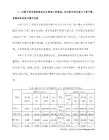
Chapter 1 International Trade Terms and Customs国际贸易术语与国际贸易惯例1.1 Trade Terms and Customs国际贸易术语与国际贸易惯例Definitions and functions of international trade terms国际贸易术语的概念及作用International commodity prices are consisted of not only unit price and amount but also related liabilities, costs and risks between the seller and buyer.国际贸易商品价格构成中,除了要表明每一计量单位的价格、金额外,还要表明买卖双方在货物交接过程中有关责任、费用、风险的划分问题。
DefinitionTrade terms, also called price terms or price conditions, are abbreviations of letters or words specifying specific certain liabilities, costs and risks between the seller and buyer.国际贸易术语(Trade Terms)也称为价格术语、价格条件,它是指用短语或英文缩写来说明商品的价格构成及买卖双方在货物的交接过程中有关的风险、责任和费用划分问题的专门用语。
It covers two basic elements: 1) trade terms indicate commodity price composition, for instance, whether the seller’s quotation includes freight, insurance premium or discharge. FOB excludes freight and insurance premium which are paid by the buyer. And CIF is the opposite. 2) Trade terms are specified terms concerning place of delivery, risks, obligations and costs during delivery of goods between the seller and the buyer.这一定义包含两层意思,第一层含义:贸易术语说明了商品的价格构成,卖方所报价格是否包含运费、保费、装缷费是离岸价还是到目的港的价格。
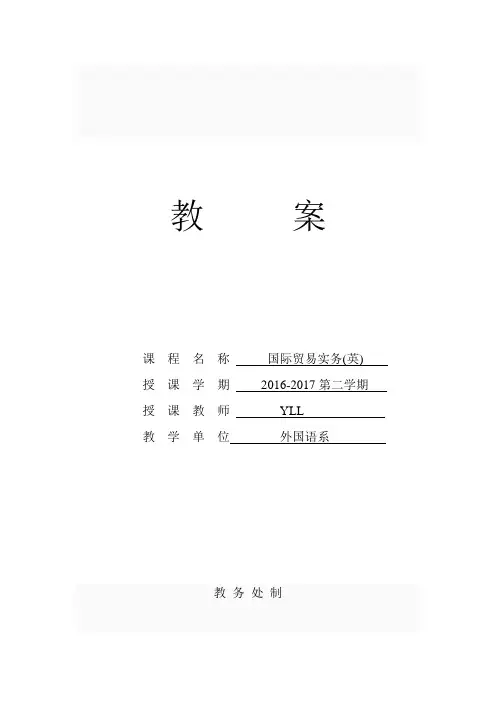
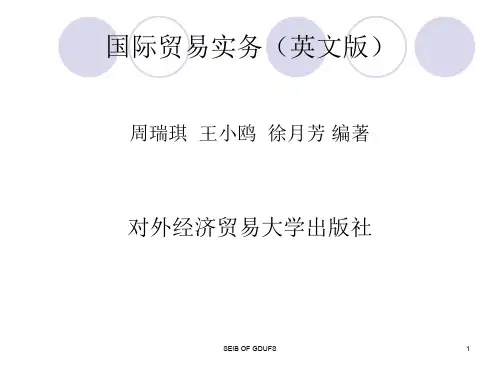

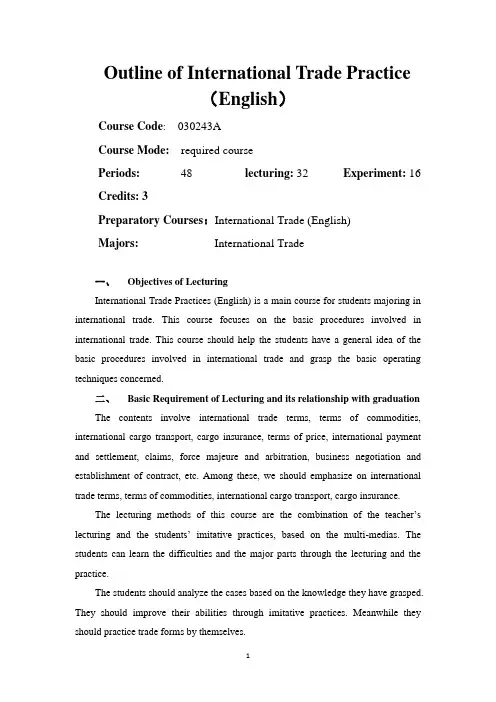
Outline of International Trade Practice(English)Course Code: 030243ACourse Mode:required coursePeriods: 48 lecturing: 32 Experiment: 16 Credits: 3Preparatory Courses:International Trade (English)Majors: International Trade一、Objectives of LecturingInternational Trade Practices (English) is a main course for students majoring in international trade. This course focuses on the basic procedures involved in international trade. This course should help the students have a general idea of the basic procedures involved in international trade and grasp the basic operating techniques concerned.二、Basic Requirement of Lecturing and its relationship with graduationThe contents involve international trade terms, terms of commodities, international cargo transport, cargo insurance, terms of price, international payment and settlement, claims, force majeure and arbitration, business negotiation and establishment of contract, etc. Among these, we should emphasize on international trade terms, terms of commodities, international cargo transport, cargo insurance.The lecturing methods of this course are the com bination of the teacher’s lecturing and the students’ imitative practices, based on the multi-medias. The students can learn the difficulties and the major parts through the lecturing and the practice.The students should analyze the cases based on the knowledge they have grasped. They should improve their abilities through imitative practices. Meanwhile they should practice trade forms by themselves.三、The allocation of periods for the contentsAllocation四、Contents of LecturingChapter 1 International Trade Terms1.1Generalization1.2 A Guide to Incoterms 2000 and 20101.3Incoterms and ContractsThe difficulties and the major parts: the definition of trade terms, the responsibilities and obligations born by the buyer and the seller in each trade terms.Learning criterion: After learning the chapter, the students should have a general idea of the function of the trade terms, understand the implication and features of each trade terms and grasp the differences among certain trade terms.Exercises: Case studyChapter 2 Terms of Commodity2.1 Name of Commodity2.2 Quality of Commodity2.3 Quantity of Commodity2.4 Packing of Commodity2.5 Commodity Inspection and Customs FormalitiesThe difficulties and the major parts: the methods to stipulate the name of the commodity and the quality, calculation of weight, neutral packing.Learning criterion: After learning the chapter, the students should have a general idea of the name of commodity, the quality, the quantity and the packing, understand the methods to describe the name of commodities and the quality, and grasp the techniques to describe the name of commodities the quality, the quantity and the packing in the international contract.Exercise: Case studyChapter 3 International Cargo Transport3.1 Modes of Transport3.2 Clause of Shipment3.3 Major Shipping DocumentsThe difficulties and the major parts: ocean transport, clause of shipment, the function and the type of the bill of ladingLearning criterion: After learning the chapter, the students should have a general idea of the mode of transport and its features, understand the clause of shipment and grasp the function and the type of the B/L.Exercise: Case studyChapter 4 Cargo Insurance4.1 Parties to the Insurance4.2 Marine Insurance4.3 Insurance of Land, Air and Postal Transportation4.4 Fundamental Principles of Cargo InsuranceThe difficulties and the major parts: types of risks, losses and expenses covered, scope of insurance coverageLearning criterion: After learning the chapter, the students should have a general idea of the scope of insurance coverage, understand the implication of basic coverage and additional coverage and their respective scope of insurance coverage, and grasp the methods to cover insurance in international trade.Exercise: Case studyChapter 5 Terms of Price5.1 Conversion of Major Trade Terms5.2 Exchange Cost5.3 Money of Account and Avoidance of Foreign Exchange Risk5.4 Use of Commission and Discount5.5 Clause of PriceThe difficulties and the major parts: conversion of major trade terms, exchange cost, use of commission and discountLearning criterion: After learning the chapter, the students should have a general idea of the pricing strategies, understand the implication and use of commission and discount, and grasp the conversion of major trade term, exchange cost and clause of price.Exercise: Case studyChapter 6 International Payment and Settlement6.1 Payment Currency6.2 Credit Instruments6.3 Payment Methods6.4 Risk Level Assessment of PaymentsThe difficulties and the major parts: collection and letter of creditLearning criterion: After learning the chapter, the students should have a general idea of the flow of a documentary credit and a collection, understand the implication and features of remittance, collection and L/C, and grasp the chief contents and the varieties of the L/C.Exercise: Case studyChapter 7 Claims, Force Majeure and Arbitration7.1 Claims7.2 Force Majeure7.3 ArbitrationThe difficulties and the major parts: claims, force majeure and arbitrationLearning criterion: After learning the chapter, the students should have a general idea of the definition of the terms such as claims, force majeure and arbitration, understand the function of the clause of force majeure, and grasp the force majeure clause in the contract.Exercise: Case studyChapter 8 Business Negotiation and Establishment of Contract8.1 Enquiry8.2 Offer8.3 Counter-offer8.4 Acceptance8.5 Conclusion of ContractThe difficulties and the major parts: offer with engagement, conclusion of contractLearning criterion: After learning the chapter, the students should have a general idea of the stages in the business negotiation, understand the two required factors, and grasp the meaning of acceptance and conclusion of contract.Exercise: Case study五、ExaminationThis subject adopts a written examination, with the final score accounting for 70% and imitative practices accounting for 30%.六、Bibliography[1] William G. Nickels, James M. McHugh, Susan M. McHugh. Understanding Business. 6th ed. McGraw-Hill. 2002[2] Paul R. Krugman and Maurice Obstfeld. International Economics---theory and Policy. 5th ed. Addison Wesley Longman & 清华大学出版社,2002[3] Lillian H. Channey and Jeanette S. Martin. Intercultural Business Communication. 2nd ed. Pearson Education. 2002[4] 帅建林.International Trade Practices (Second Edition). Beijing: University of International Business and Economics Press. 2012[5]帅建林.International Trade Practices (Third Edition). Beijing: University of International Business and Economics Press. 2015执笔人:于晓云教研室主任:系教学主任审核签名:。
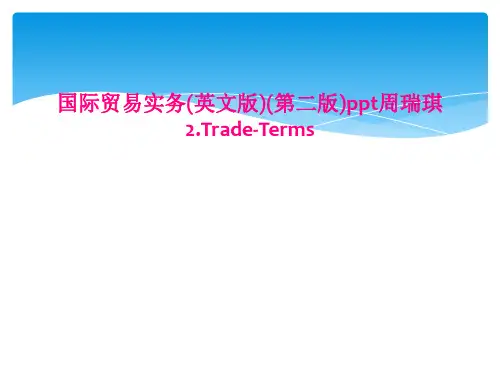
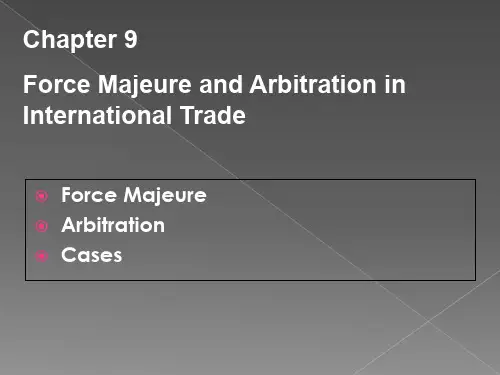
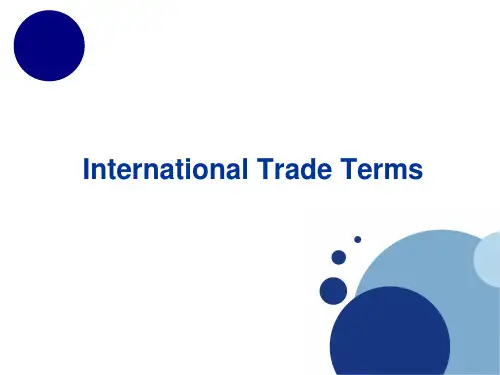
![国际贸易实务双语教程Chapter1 International Trade Terms and Customs[精]](https://uimg.taocdn.com/e674bf5db84ae45c3b358c90.webp)

国际贸易实务教案Chapter 1 Brief Introduction to International Trade国际贸易简介1.1 Reasons for international trade1.1.1Resources Reasons(1) Natural resources.(2) Favorable climate conditions and terrain.(3) Skilled workers and capital resources.(4) Favorable geographic location and transportation costs.1.1.2Economic Reasons(1) Comparative advantage(2) Strong domestic demand(3) Innovation or style1.1.3Political Reasons1.2 Problems Concerning International Trade1.2.1Cultural Problems(1) Language.(2) Customs and manners.1.2.2Monetary Conversions1.2.3Trade BarriersIndividual countries put controls on trade for the following three reasons:(1) To correct a balance-of-payments deficit.(2) For reasons of national security.(3) To protect their own industries against the competition of foreign goods.Although tariffs have been lowered substantially by international agreements, countries continue to use other devices to limit imports or to increase exports. Some of these are:(1) requiring import licenses that permit only specific volumes or values imports;(2) setting quotas that limit the total value or volume of a product to be imported;(3) limiting government purchases to firms within the country;(4) applying standards for safety, consumer protection, or other reasons, which foreign products may not be able to meet;(5) making special payments called export subsidies to encourage local exporters to increase foreign sales;(6) targeting——a new term meaning the imposition of a package of measures to give certain local industries a competitive advantage in export markets. It might include export subsidies, technical assistance, subsidies for research and development, and financial assistance;(7) requiring licenses to obtain foreign currencies by those who want to buy goods from abroad——thus limiting the quantity of imports they can buy;(8) reducing the value of a nation’s currency in relation to that of the rest of the world so that its exported goods cost less in other countries and its imports cost more;(9) imposing conditions on foreign products such as requiring that their goods contain a certain amount of locally produced products;(10) restricting trade in banking, insurance, and other service professions.练习一:导论思考题:1国际贸易实务课程的主要任务和研究对象是什么?本课程包括哪些主要内容?2与国内贸易相比进出口贸易有何特点?3国际贸易中影响较大的惯例、条约有哪些?其主要内容是什么?有何特点?4根据我国合同法规定,合同应包括哪些主要内容?5进出口贸易一般要经过哪几个步骤?在进出口业务中,出口商/进口商的主要工作是什么?Chapter 5. Trade Terms and Export PricingPart I. Outline本章要点5.1 Trade Terms and International Trade Practices贸易术语与国际贸易惯例5.2 13 Trade Terms in INCOTERMS 2000《2000通则》中的13中贸易术语5.3 Selection of Trade Terms贸易术语的选用5.4 Export Pricing出口定价5.1Trade Terms and International Trade Practices贸易术语与国际贸易惯例5.1.1 国际货物买卖适用的法律与惯例1、交易双方当事人所在国的国内法2、国家对外缔结或参加的有关国际贸易、国际运输、商标、专利、仲裁等方面的条约和协定。
Chapter 1 Introduction to International tradeQuestions & Answers (terms)•International trade(the fair and deliberate exchange of goods and/or services across national boundaries)•Trade in goods (the purchase and sale of visible goods:coffee, chemicals, airplanes, textiles, tobacco)&Trade in services(the purchase and sale of invisible goods: transportation, insurance, tourism, hotel accommodations, commerce)•Self-sufficient (someone who does his own hunting, finds his own shelter, and provides for his own needs)•Barter (the trade of goods without any exchange of money)•Balance of trade (a nation’s rel ationship of exports to imports). A favorable balance of trade, or trade surplus, occurs when the value of the country’s expor ts exceeds that of its imports;An unfavorable balance of trade, or trade deficit, occurs when the value of the country’s imports exceeds that of its exports.•Balance of payments [the difference between money coning into a country (from exports) and money going out of the country (for import) plus money flows coming into or leavinga country from other factors such as tourism, foreign aid.BOP=EM-IM+MF]. Afavorable balance of payments means more money is flowing into a country than flowing out;An unfavorable balance of payments is when more money is flowing out ofa country than coming in.•Dumping(the practic of selling products in foreign country at lower prices than those charged in the producing country). Companies use this tactic to reduce surplus products in foreign markets or to gain a foothold in a new market by offering products for lower prices than domestic competitors do.The foundation of international trade and economic activities:In today’s complex economic world, neither individuals nor nations are self-sufficient. Nations have utilized different economic resources; people have developed different skills.Questions & Answers (text)•What are major reasons of the exchange of goods between nations?✧First, no nation has all of the commodities that it needs.✧Second, a country often does not have enough of a particular item to meet its needs.✧Third, one nation can sell some items at a lower cost than other countries.✧Finally, foreign trade takes place because of innovation or style (fashion).•Why is FDI now more important than trade?✧First, FDI enables host country to build a new manufacturing plant and to payworkers to build it.✧Second, once the plant is operative, it provides both jobs and taxes for host country.✧Third, FDI acts as a catalyst (催化剂) in economic growth for host country.•Why inflows into Sub-Saharan Africa have increased?Tourism is the world's largest industry and every year it pumps billions of dollars into some of the poorest countries in the world. It creates jobs, reduces poverty, builds new roads, airports, hotels and hospitals.•What are major obstacles to Chinese foreign trade?✧Firstly, China should deal with pressure from international markets that aregradually becoming saturated(饱和).✧Secondly, the cost of Chinese exports is increasing, partly because of the highercost of labor and environmental protection.✧Thirdly, increasing international trade protection has caused China to stumble into(陷入)difficult territory.✧Finally, the trade imbalance between China and other countries is getting worse.Chapter 2 Basic Theory of International TradeQuestions & Answers (terms)•Opportunity Cost机会成本:有一得必有一失(the amount of another goods or service that might otherwise have been produced)•Absolute Advantage两者相权取成本低、效率高者[A commodity will be produced in the country where it costs least in terms of resources (capital, land, and labor).] Comparative Advantage两利相权取其重,两劣相权取其轻only one of the goods would work "most best" and "least worse"•What the Theory of C-A Shows if we want to maximize total output in the world then:✧first, fully employ all resources worldwide;✧second, allocate those resources within countries to each country's comparativeadvantage industries;✧third, allow the countries to trade freely .•Specialization (there were some things he was more capable of doing and it would benefit him to concentrate his efforts on the production of those goods in which he was particularly proficient)What are the major benefits of exporting?Why export? Y our general objectives will probably be:➢To increase profitability➢To utilise production capacity to the full➢The small domestic market may not big enough for growth➢You may be manufacturing a specialised product and find there are not enough customers in Sweden➢You may be looking for the increased security your company can achieve by spreading its risks over a variety of markets➢You may want to ensure that your product is kept up to date by exposure to competition in international markets➢It provides scope to develop a company's strengths and abilities. Selling in aninternational environment will sharpen your innovative edge and open up opportunities that might never come your way if you limit yourself to the home market.Michael Porter’s Diamond ModelMichael Porter of the Harvard Business School introduced a new competitiveness theory, the so-called diamond model. He argues that national prosperity is not inherited, but created by choices; in other words, national wealth is not set by factor endowments, but created by strategic choices. He intro duced a concept of “clusters”, or groups of interconnected firms, suppliers,related industries, and institutions that arise in particular locations.1. Firm strategy, Structure and RivalryThe world is dominated by dynamic conditions, and it is direct competition that impels firmsto work for increases in productivity and innovation.2. Demand ConditionsThe more demanding the customers in an economy, the greater the pressure facing firms to constantly to improve their competitiveness via innovative products, through high quality, etc.3. Related Supporting IndustriesUpstream or downstream industries facilitates the exchange of information and promotes a continuous exchange of ideas and innovations.4. Factor ConditionsContrary to conventional wisdoms, Po rter argues that the “key” factors of production (or specialized factors) are created, not inherited. Specialized factors are skilled labor, capital and infrastructure. “Non-key” factors or general use factors, such as unskilled labor and raw materials, can be obtained by any company and, hence, do not generate sustained competitive advantage. However, specialized factors involve heavy, sustained investment. They are more difficult to duplicate. This leads to a competitive advantage, because if other firms cannot easily duplicate these factors, they are valuable.The role of government in Porter’ Diamond Model is “acting as a catalyst and challenger; it is to encourage—or even push—companies to raise their aspirations and move to higher levels of competitive performance…”.They must encourage companies to raise their performance, stimulate early demand for advanced products, focus on specialized factors creation and to stimulate local rivalry by limiting direct cooperation and enforce anti-trust(反托拉斯,反垄断)regulations.Chapter 5 International Trade TermsRole of International Trade Terms➢Standing for specific obligations of the buyer and the seller.➢Name the exact point at which the ownership of the merchandise is transferred from the seller to the buyer.➢Define the responsibilities and expenses of both the seller and the buyer.➢Define the nature of the contract, such as FOB contract or CIF contract, to determine expenses and risks as well as their rights and obligations accordingly.➢The use of the trade terms greatly simplifies the contract negotiations, and thus saves time and cost.The price of commodity(refers to the unit price, which is made up of a name of currency, a unit price, a measuring unit, a trade term, and a name of destination or shipping place .For example,US$ 800 per M/T CIF London)国际贸易合同的主要条款有: 合同对象(标的):commodities or services 合同总值: total value or quantities 交货条件: trade terms 包装: packaging 装运期: shipment装运口岸和目的地: departure port or destination 保险: insurance 支付条款: payment Procedures of Marine Insurance•To apply for marine insurance;•To determine the insurance value of the goods to be insured;•To determine the insurance average and coverage;•To determine insurance premium;•To sign an insurance policy•To lodge an insurance claim.Proper pricing, complete and accurate quotations, and choice of terms of sale and payment are four critical elements in selling a product or service internationally. Of the four, pricing is the most problematic, even for the experienced exporter.Export product cost structure, involving cost of production, selling and delivery costs, and customs duties.Pricing Considerations•At what price should the firm sell its product in the foreign market?•What type of market positioning does the company want to convey from its pricing structure?•Does the export price reflect the product's quality?•Is the price competitive?•Should the firm pursue market penetration or market-skimming pricing objectives abroad?•What type of discount (trade, cash, quantity) and allowances (advertising, trade-off) should the firm offer its foreign customers?•Laws pose a problem?•Should prices differ by market segment?•What should the firm do about product line pricing?•What pricing options are available if the firm's costs increase or decrease?•Is the demand in the foreign market elastic or inelastic?•Are the prices going to be viewed by the foreign government as reasonable or unfair?•Do the foreign country's antidumping?Pricing Summary Here are the key points to remember when determining your product's price: •Determine the objective in the foreign market.•Compute the actual cost of the export product.•Compute the final consumer price.•Evaluate market demand and competition.•Consider modifying the product to reduce the export price.•Include “non-market" costs, such as tariffs and customs fees.•Exclude cost elements that provide no benefit to the export function, such as domestic advertising.In the cost-plus method of calculation, the exporter starts with the domestic manufacturing cost and adds administration, research and development, overhead, freight forwarding, distributor margins, customs charges, and profit. The effect of this pricing approach may be that the export price escalates into an uncompetitive range.The actual payment= the full invoice of the goods +the additional charges of expenses the seller has paid.Stages in Handling a Bill of Exchange•To draw•Presentation and acceptance•Endorsement•Without recourse•Payment•Dishonor and recourse。
教案课程名称国际贸易实务(英)授课学期 2016-2017第二学期授课教师YLL教学单位外国语系教务处制《国际贸易实务》教案To get to know the terms .Master the terms of International trade.To know general basic theoriesKnow reasons,benefits and problems of the international trade.I.Reasons For International Trade1. Resource reasons2. Economic reasons3. Political reasonsII.Benefit of International Trade1. Cheaper goods2. Greater variety when goods come from more countries3. Wider market with increasing number of trading partners4. Growth of economyIII.Problems in International Trade1. Trade restrictions2. Cultural Problems3. Monetary conversion1.Trade restrictionsdiversified economyprotect their vital industriesinfant industryunfair competitiondomestic jobsmaintain balance of trade and balance of paymentpure political reason2) Kinds of restrictions(1)Tariffs (tariff barriers)Import duty and Export dutyImport surtax : Countervailing duty ,anti-dumping duty, variable levySpecific dutyAd valorem dutyMixed or compound dutyAlternative duty(2) Non-tariff barriersQuotaImport licenseForeign exchange controlForeign exchange controlState monopoly of import and exportGovernment procurement policyAdvanced depositTechnical standardsHealth & sanitary regulationsPackaging and labeling regulationMinimum price《国际贸易实务》教案To acquire the basic knowledge of termsTo know how to use the termsMaster the definition of 13 trade terms.Know the difference and same among them(各种贸易术语的含义及使用中注意的问题,在装运港交货的三种常用术语的变形,相邻或相似术语之间的异同对比)FGroup F: FCA FAS FOBFGroup C: CFR CIF CPT CIPFGroup D: DAS DES DEQ DDU DDP各组贸易术语总结E组术语(启运术语,Departure)F组术语(主运费未付术语,Main Carriage Unpaid)C组术语(主运费已付术语,Main Carriage Paid)D组术语(到达术语,Arrival)注:C组术语的风险划分界限和费用划分界限相分离注:以F组和C组术语成交的合同都属于装运合同。